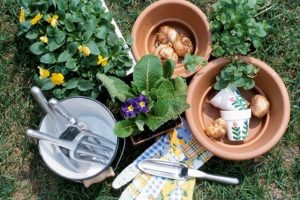It’s the time of year to check, clean, refurbish, sharpen and store those tools that helped you get through the garden season.
Equipment to have handy: safety glasses & gloves, a workbench with vise grip or C-clamp, metal file, wire brush, sandpaper, steel wool, rags, bleach or alcohol for disinfectant, boiled linseed oil, varnish, paint, or stain for wooden handles, spray lubricant or lubricating oil. Always use safety glasses and gloves. A metal sliver in the eye can ruin the day or your eye.
To work nicks out of a shovel, hoe, or ax, clamp it securely in the vise grip or C-clamp. File in one direction away from your body using one smooth stroke across the entire edge following any existing angle. Lightly smooth the other side to remove any burrs. Repeat this process until the edge is smooth. Replace cracked wooden handles but discard any cracked heads.
Clampdown pruners or clippers to sharpen. Some hedgers/clippers only need sharpening on the edge with an angle. Some can be taken apart (make sure you keep all the pieces to put them back together). Again, follow the existing slant of the blade filing away from the body in one smooth stroke across the entire edge of the tool. Try highlighting the edge with a marker pen and file until the color is gone.
If tools have become a little rusty, dunk them in a five-gallon bucket partially filled with a mixture of course sand and clean motor or vegetable oil. Dip the head several times in the bucket of sand and oil; wipe off any excess. You can use this bucket all season for storage of hand tools.
If rust is stubbornly clinging to a tool, soak in white vinegar and scrub with wire brush or steel wool. Dry with a clean rag and wipe down the metal surfaces with oil to prevent rust. Oil hinges or spray them with lubricant.
Wash wooden handles with wood soap. Wipe handles with boiled linseed oil, let set and wipe off excess with a clean rag. Paint handles with a color that makes them easier to spot in the yard. Wash fiberglass parts with soap and water. When you are finished with the dipping, scrubbing and wiping be sure to properly dispose of any rags to avoid spontaneous combustion potentially caused by chemicals and heat.
To store tools, use hooks in a peg board with each tool’s location outlined. Upright tool racks, available at the hardware store, hold long handled tools. Or pour sand in the bottom of a large, wheeled garbage can, cut circular holes in the lid, and slide in long handled tools and garden stakes. This is convenient for moving your tools around the garage or into the yard.
Small hand tools can be stored in a belt such as a carpenter’s tool belt. Clip the belt around a lidded five-gallon bucket to use as a stool or seat in the garden. Label length and width of pieces of bird netting and shade covers; store them in storage boxes for future use. Wipe down & oil tomato cages. For gasoline engine equipment, pick up an engine conditioner and run it through the machine for about five minutes. By cleaning up now you’ll be ready to go next spring.
Pat Gogas is a University of California Cooperative Extension Master Gardener of Tuolumne County. She adapted this article from The Tool Book by William Bryant Logan.
UCCE Central Sierra Master Gardeners can answer home gardening questions. Call 209-533-5912 in Tuolumne County, 209-754-2880 in Calaveras County or you can fill out our easy-to-use problem questionnaire here. Check out our website here. You can also find us on Facebook.

